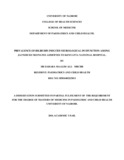| dc.contributor.author | Dahaba, Maalim A | |
| dc.date.accessioned | 2017-12-14T06:23:28Z | |
| dc.date.available | 2017-12-14T06:23:28Z | |
| dc.date.issued | 2017 | |
| dc.identifier.uri | http://hdl.handle.net/11295/101869 | |
| dc.description.abstract | Background: Hyperbilirubinemia is a common and often benign problem in neonates. In the first week of life around 60% of term neonates and 80% of preterm neonates develop jaundice. Untreated severe unconjugated hyperbilirubinemia is potentially neurotoxic while conjugated hyperbilirubinemia signifies serious hepatic or systemic illness. Neonatal jaundice is a major cause of mortality and morbidity characterized by acute bilirubin encephalopathy, kernicterus and subsequently chorio-athetoid cerebral palsy.
Study justification:-The local prevalence of bilirubin induced neurological dysfunction is not known and the BIND criteria have not been adopted as standard for newborn assessment. This study is set to estimate the magnitude of the problem as it is easily preventable using simple measures.
Objectives: primary objective: To determine the prevalence of bilirubin induced neurological dysfunction (BIND) in jaundiced neonates admitted to Kenyatta National Hospital.
Secondary objectives: To describe the short term outcomes of neonates with BIND. The specific outcomes are mortality and the status of neurologic function within seven days of admission.
Study design: Primary objective: A cross sectional study.
Secondary objective: Short longitudinal survey.
Study period: From April to June 2016.
Settings: The general paediatric wards and newborn unit of Kenyatta National Hospital.
Subject: All newborns presenting with jaundice who met the inclusion criteria.
Methods: All term neonates aged one to fourteen days of life presenting with jaundice, whose guardian/parents gave written informed consent were assessed. A pretested questionnaire was administered to collect data on prenatal and birth history to assess gestational age and to rule out other co morbid conditions like asphyxia. This was then followed by screening for the presence of jaundice using physical examination. Thereafter neurological examination was carried out within or at 12 hours post admission to determine the initial bilirubin induced neurological dysfunction score. Repeat neurological examinations were performed at 72 hours post admission and at seven days using the clinical BIND scoring system to assess the short term outcomes. The BIND scoring system was administered to detect changes in mental states, muscle tone and cry pattern of neonates affected with
xi
acute bilirubin encephalopathy. Each category was assigned a total score of 0 to 3, yielding a total score ranging from 0 to 9.
RESULTS
Eighty eight neonates were enrolled into the study, of these 59 were females and 29 were males. The mean birth weight was 3070 grams SD 0.41 and mean weight at admission was 3600 grams SD 0.78. The mean gestational age at birth was 39 weeks SD 1.35 and all neonates were admitted at a mean age of 5days SD 2.41. Using the BIND scoring criteria, the prevalence of bilirubin induced neurological was as follows according to the severity, fifty eight 65.9% had subtle acute bilirubin encephalopathy, twenty seven 30.7% had moderate acute bilirubin encephalopathy and two 2.3% had severe acute bilirubin encephalopathy at twelve hours post admission.
After a repeat neurological examinations within 72 hours of admission to determine the short term outcome, the prevalence of BIND was as follows twenty nine 33.3% had subtle ABE, six 6.9% had moderate ABE and one 1.1% had severe ABE. The mortality was one 1.1% and twelve 13.8% had neurological deficit at seven days post admission.
CONCLUSION
The prevalence of bilirubin induced neurological dysfunction was initially very high with almost all the neonates (except one) manifesting signs and symptoms of bilirubin toxicity. A high promotion of these neonates had subtle acute bilirubin encephalopathy 65.9% within 12 hours of admission which were reversed almost 90% at the end of the study period. Mortality was low at one 1.1% and 12 neonates 13.8% had neurological deficit at seven days post admission. | en_US |
| dc.language.iso | en | en_US |
| dc.publisher | University of Nairobi | en_US |
| dc.rights | Attribution-NonCommercial-NoDerivs 3.0 United States | * |
| dc.rights.uri | http://creativecommons.org/licenses/by-nc-nd/3.0/us/ | * |
| dc.subject | Prevalence of Bilirubin Induced Neurological Dysfunction Among Jaundiced Neonates Admitted to Kenyatta National Hospital. | en_US |
| dc.title | Prevalence of Bilirubin Induced Neurological Dysfunction Among Jaundiced Neonates Admitted to Kenyatta National Hospital. | en_US |
| dc.type | Thesis | en_US |
| dc.description.department | a
Department of Psychiatry, University of Nairobi, ; bDepartment of Mental Health, School of Medicine,
Moi University, Eldoret, Kenya | |



